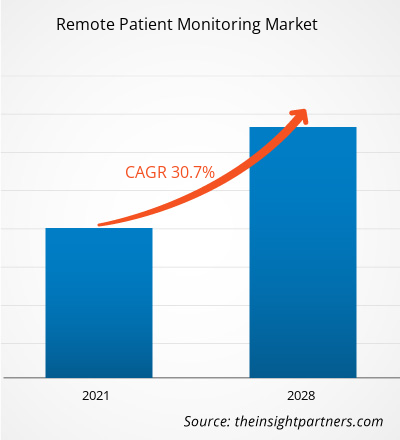远程病人监护市场规模预计将呈现爆炸式增长,到2034年将达到惊人的11811.7亿美元,远高于2025年的1091.3亿美元。预计在2026年至2034年的预测期内,该市场将保持30.30%的强劲复合年增长率(CAGR)。
远程患者监护市场分析
全球远程患者监护 (RPM) 市场预测显示,该市场将持续呈指数级增长,主要驱动力是全球慢性病负担的显著加重,例如糖尿病、高血压和心血管疾病。远程医疗和数字健康解决方案的日益普及进一步促进了这一增长,尤其是在新冠疫情期间及之后,这些解决方案的普及速度显著加快。物联网 (IoT) 医疗设备的快速发展和普及使得从患者家中无缝、实时地采集数据成为可能。医疗服务提供商和支付方正日益利用 RPM 系统来实现关键的机构目标:改善患者预后、降低高昂的医院再入院率,并通过将常规监测从门诊转移到远程进行,从而优化临床资源的利用。
远程患者监护市场概览
远程患者监护 (RPM) 利用先进的数字技术,在传统临床环境之外,采集患者的重要生理数据和其他健康指标。这些数据随后以电子方式传输给医疗服务提供者,以便他们评估患者状况、及时干预并提供个性化的治疗建议。RPM 解决方案是一个综合系统,包含联网医疗设备(例如血压计、连续血糖监测仪、可穿戴传感器)、用于数据聚合和警报的专用软件平台,以及实施和患者支持所需的配套服务。该市场充满活力,其特点是技术不断创新、监管支持有利(尤其是在北美和欧洲的报销政策方面),以及全球对强大的数字医疗基础设施的大量投资。
根据您的需求定制此报告
您可以免费获得任何报告的定制服务,包括本报告的部分内容、国家/地区层面的分析、Excel 数据包,以及面向初创企业和高校的优惠折扣。
远程患者监护市场:战略洞察

-
获取本报告的主要市场趋势。这份免费样品将包含数据分析,内容涵盖市场趋势、估算和预测等。
远程患者监护市场驱动因素和机遇
市场驱动因素:
- 慢性病患病率上升:慢性病发病率不断上升,治疗周期不断延长,因此需要持续监督,这使得远程患者监护成为在大患者群体中主动进行疾病管理和预防并发症的不可或缺的工具。
- 远程医疗和数字健康解决方案的日益普及:虚拟护理模式的接受度不断提高,基础设施也更加完善,使得远程患者监护 (RPM) 系统的实施更加顺利,远程监护成为综合数字医疗保健服务的基础要素。
- 更加注重降低医疗保健成本和改善患者预后:支付方和提供方有动力采用远程患者管理,因为它能有效降低支出,预防急性发作,减少不必要的急诊就诊,并减少昂贵的住院治疗和再入院。
市场机遇:
- 将人工智能和预测分析集成到远程患者监护平台:实施复杂的人工智能 (AI) 和机器学习算法,使平台能够处理大量患者数据,识别健康状况的细微变化,预测潜在的危急事件,并生成优先警报以进行临床干预。
- 随着互联网连接的改善,新兴市场正在扩张:亚太和拉丁美洲的新兴市场蕴藏着巨大的、尚未开发的机遇,因为互联网连接的改善以及政府机构优先考虑数字化转型举措,以增强偏远或服务不足地区的医疗服务可及性。
- 技术提供商与医疗机构之间的战略伙伴关系:纯粹的远程患者监护技术公司、成熟的医疗器械制造商以及大型医院网络或保险公司之间的合作对于扩大解决方案规模、确保互操作性以及推动临床验证和部署至关重要。
远程患者监护市场报告细分分析
远程患者监护市场份额按不同细分市场进行分析,以便更清晰地了解市场结构、技术组成和终端用户采用模式。以下是大多数行业报告中使用的标准细分方法:
按类型:
- 设备
- 软件
- 服务
按最终用户:
- 医疗服务提供者(医院、诊所、医生)
- 付款方(保险公司)
- 患者(直接面向消费者)
按地理位置:
- 北美
- 欧洲
- 亚太地区
- 南美洲和中美洲
- 中东和非洲
远程患者监护市场区域洞察
The Insight Partners 的分析师对预测期内远程患者监护市场的区域趋势和影响因素进行了详尽的阐述。本节还探讨了北美、欧洲、亚太、中东和非洲以及南美和中美洲等地区的远程患者监护市场细分和地域分布情况。
远程患者监护市场报告范围
| 报告属性 | 细节 |
|---|---|
| 2025年市场规模 | 1091.3亿美元 |
| 到2034年市场规模 | 11811.7亿美元 |
| 全球复合年增长率(2026-2034 年) | 30.30% |
| 史料 | 2021-2024 |
| 预测期 | 2026-2034 |
| 涵盖部分 |
按类型
|
| 覆盖地区和国家 |
北美
|
| 市场领导者和主要公司简介 |
|
远程患者监护市场参与者密度:了解其对业务动态的影响
远程患者监护市场正快速增长,这主要得益于终端用户需求的不断增长,而终端用户需求的增长又源于消费者偏好的转变、技术的进步以及对产品优势认知的提高。随着需求的增加,企业不断拓展产品和服务,持续创新以满足消费者需求,并把握新兴趋势,这些都进一步推动了市场增长。

- 获取远程患者监护市场主要参与者概览
按地域划分的远程患者监护市场份额分析
北美市场份额最大,亚太地区在预测期内复合年增长率最高。
由于报销政策、数字医疗成熟度和监管框架的差异,远程患者监护 (RPM) 市场的增长轨迹因地区而异。以下是按地区划分的市场份额和趋势概述:
北美
- 市场份额:由于高度先进的医疗保健基础设施、对数字健康技术的早期大量投资以及有利的报销代码(例如在美国),激励医疗服务提供者提供远程患者监护服务,因此在全球市场占据主导地位。
- 主要驱动因素:领先的科技和医疗保健公司拥有强大的市场地位并率先采用该产品。
- 趋势:通过远程患者监护 (RPM) 提高慢性病管理报销的复杂性,并朝着将 RPM 数据直接整合到电子健康记录 (EHR) 系统的方向发展。
欧洲
- 市场份额:占据相当大的市场份额,这得益于政府支持数字健康整合的政策,尤其是在公共医疗保健系统(如英国国家医疗服务体系)中。
- 关键驱动因素:严格的数据治理政策(GDPR)推动了对高度安全的远程患者监护 (RPM) 解决方案的需求。
- 趋势:结合面对面就诊和持续远程监测的混合护理模式发展强劲,尤其适用于心脏病和呼吸系统疾病患者。
亚太
- 市场份额:全球增长最快的地区,这得益于医疗保健快速数字化带来的巨大机遇、庞大人口(中国、印度)面临的严重慢性病负担,以及农村地区远程医疗服务的不断扩展。
- 关键驱动因素:消费者对采用联网健康设备和可穿戴设备的意愿不断提高。
- 趋势:专注于开发本地化、经济高效的远程患者监护解决方案,并将移动平台作为患者参与和数据传输的主要界面。
南美洲和中美洲
- 市场份额:新兴市场,具有巨大的潜力,其特点是互联网连接不断改善,政府努力弥合医疗保健服务方面的差距。
- 主要驱动因素:医疗专业人员对远程患者监护的效率和可扩展性的认识不断提高。
- 趋势:采用基于云和可扩展的平台,以服务地理位置分散的人群,并解决城乡医疗保健方面的差异。
中东和非洲
- 市场份额:发展中市场展现出强大的潜力,这得益于政府以经济多元化和通过技术提高医疗保健服务质量为重点的重大战略。
- 主要驱动因素:高净值人士和外籍人士对先进的互联健康解决方案的需求。
- 趋势:将远程患者管理 (RPM) 作为大型综合健康信息系统 (HIS) 的一部分进行实施,以优化新兴和不断扩展的医疗城市的资源分配。
远程患者监护市场参与者密度:了解其对业务动态的影响
竞争格局高度分散,其特点是多元化的跨国医疗保健集团与专注于创新技术的初创企业并存。主要供应商优先考虑技术领先地位以及在整个医疗保健服务链中的无缝整合。
这种竞争环境促使供应商通过以下方式实现差异化:
- 与临床工作流程集成:开发与所有主要 EHR/EMR 系统(Epic、Cerner 等)无缝集成的平台,以确保 RPM 数据在提供者的原生工作流程中可操作。
- 设备便携性和准确性:传感器技术的不断创新,旨在创造更小、侵入性更小、临床更准确的可穿戴设备,从而提高患者的依从性和舒适度。
- 网络安全与合规性:提供符合严格的全球数据隐私和安全法规(HIPAA、GDPR)的企业级安全架构,以建立与大型医疗保健系统和支付方的信任。
远程患者监护市场的主要运营公司包括:
- 美敦力
- 皇家飞利浦公司
- Cerner公司(甲骨文)
- GE医疗
- 雅培
- 波士顿科学公司
- 西门子医疗股份公司
- VitalConnect
- 日本光电株式会社
免责声明:以上列出的公司不分先后顺序。
远程病人监护市场新闻及最新进展
- 美敦力公司推出了HealthCast™ Vital Sync™ RPM平台,该平台能够跨设备和电子病历系统近乎实时地追踪血氧饱和度(SpO₂)、呼吸频率、脉搏、呼气末二氧化碳分压(EtCO₂)和呼吸机数据。该解决方案优化了医院的监护工作流程,并有助于及早发现患者病情恶化。
- 飞利浦与smartQare合作,将viQtor可穿戴生物传感器集成到飞利浦临床监护平台中,从而实现院内外的连续监护。此外,飞利浦还与美敦力签署了一项多年合作协议,将飞利浦监护仪与美敦力传感器和耗材捆绑销售,确保集成方案经过验证且网络安全可靠。
- Oracle Health 开发了一套全面的远程患者监护 (RPM) 解决方案,并将其嵌入到其电子病历 (EHR) 和人群健康系统中。该框架包括设备连接、患者门户、用户体验工具、视频问诊和基于云的 RPM 功能,以支持慢性病管理和远程临床试验。
远程患者监护市场报告涵盖范围及成果
《远程病人监护市场规模及预测(2021-2034)》报告对市场进行了详细分析,涵盖以下领域:
- 远程病人监护市场规模及预测,涵盖全球、区域和国家层面的所有主要市场细分领域。
- 远程病人监护市场趋势,以及市场动态,例如驱动因素、制约因素和主要机遇。
- 详细的PEST和SWOT分析。
- 远程病人监护市场分析,涵盖关键市场趋势、全球和区域框架、主要参与者、法规和近期市场发展。
- 行业格局和竞争分析,包括市场集中度、热力图分析、主要参与者以及远程病人监护市场的最新发展。
- 公司详细简介。
- 历史分析(2 年)、基准年、预测(7 年)及复合年增长率
- PEST和SWOT分析
- 市场规模、价值/数量 - 全球、区域、国家
- 行业和竞争格局
- Excel 数据集
近期报告
客户评价
购买理由
- 明智的决策
- 了解市场动态
- 竞争分析
- 客户洞察
- 市场预测
- 风险规避
- 战略规划
- 投资论证
- 识别新兴市场
- 优化营销策略
- 提升运营效率
- 顺应监管趋势






















 获取免费样品 - 远程患者监护市场
获取免费样品 - 远程患者监护市场